10 Hits for November 2010
Albums (0) & Images (10)
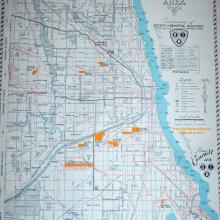
Chicago Society of Industrial Realtors 1947 Map Vertical
Chicago Society of Industrial Realtors 1947 Map Vertical
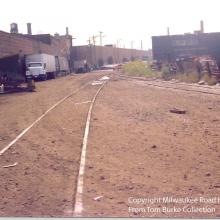
tb_mrha_CandENorthLine_09_1980_01
This view looks south on Kingsbury at C&E Junction just ahead. C&E Junction was the place where the Bloomingdale Line joined the C&E Line. After the southern end of the C&E South Line was cut at Grand Avenue in 1973 the only access to C&E, Deering, and Goose Island trackage was via the Bloomingdale Line.tb_mrha_CandENorthLine_09_1980_01
This view looks south on Kingsbury at C&E Junction just ahead.
C&E Junction was the place where the Bloomingdale Line joined
the C&E Line. After the southern end of the C&E South Line
was cut at Grand Avenue in 1973 the only access to C&E,
Deering, and Goose Island trackage was via the Bloomingdale Line.

tb_mrha_CandENorthLine_09_1980_02
We’re looking north now on dirt-paved Kingsbury Street with Cortland Avenue in the distance. Presumably the two men in suits are Milwaukee Road managers on foot on the inspection trip.tb_mrha_CandENorthLine_09_1980_02
We’re looking north now on dirt-paved Kingsbury Street with Cortland Avenue in the distance. Presumably the two men in suits are Milwaukee Road managers on foot on the inspection trip.

tb_mrha_CandENorthLine_09_1980_03
The camera is facing west along the Bloomingdale Line with the Chicago River drawbridge in the distance. This scene is similar today though it would be trains of shortline railroad Chicago Terminal on the rails now.tb_mrha_CandENorthLine_09_1980_03
The camera is facing west along the Bloomingdale Line with the Chicago River drawbridge in the distance. This scene is similar today though it would be trains of shortline railroad Chicago Terminal on the rails now.
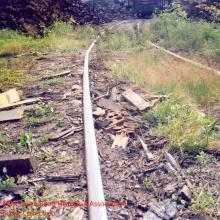
tb_mrha_CandENorthLine_09_1980_04
The photographer is now turned around and facing east by southeast where the Bloomingdale Line curves to meet the C&E Line. Note the gondola spotted at the scrapyard which continues in operation today as General Iron Industries. It still is a rail customer.tb_mrha_CandENorthLine_09_1980_04
The photographer is now turned around and facing east by southeast
where the Bloomingdale Line curves to meet the C&E Line. Note
the gondola spotted at the scrapyard which continues in operation
today as General Iron Industries. It still is a rail customer.
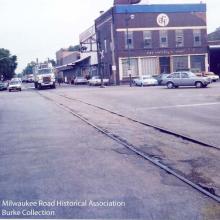
tb_mrha_CandENorthLine_09_1980_05
Moving up the C&E Line we are looking north at Lakewood Avenue where it crosses busy Lincoln Avenue. Note the cantilevered signals protecting this intersection. They no longer work by this date as the Milwaukee Road was granted an exception from the ICC a short time earlier to label the C&E as “exempt” status meaning that grade crossings were to be protected by hand flagging from the conductor on the ground instead. This ruling spared the Milwaukee Road the hassles and expenses of having to maintain the frequently vandalized crossing signals. It also made for 10 MPH maximum operating speeds.tb_mrha_CandENorthLine_09_1980_05
Moving up the C&E Line we are looking north at Lakewood Avenue
where it crosses busy Lincoln Avenue. Note the cantilevered signals
protecting this intersection. They no longer work by this date as
the Milwaukee Road was granted an exception from the ICC a short
time earlier to label the C&E as “exempt” status meaning that
grade crossings were to be protected by hand flagging from the
conductor on the ground instead. This ruling spared the Milwaukee
Road the hassles and expenses of having to maintain the frequently
vandalized crossing signals. It also made for 10 MPH maximum
operating speeds.

tb_mrha_CandENorthLine_09_1980_06
We are at Diversey Parkway and looking south down Lakewood Avenue. On the left or east is Peerless Confectionary, a reliable rail customer into the Chicago Terminal era of operation until it closed in 2007, some 27 years after this photo was taken. To the right or west is the Continental Baking bakery where Hostess products were made. You can see the spur veering off to the right. This spur was visible for years long after the bakery was torn down.tb_mrha_CandENorthLine_09_1980_06
We are at Diversey Parkway and looking south down Lakewood Avenue. On the left or east is Peerless Confectionary, a reliable rail customer into the Chicago Terminal era of operation until it closed in 2007, some 27 years after this photo was taken. To the right or west is the Continental Baking bakery where Hostess products were made. You can see the spur veering off to the right. This spur was visible for years long after the bakery was torn down.
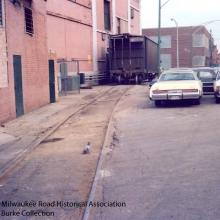
tb_mrha_CandENorthLine_09_1980_07
Here’s a picture of Continental Baking with a covered hopper on the spur alongside the building. Perhaps it contains flour or sugar. Ahead, to the north, is busy Diversey Parkway. The bakery was torn down sometime around 1984 and replaced with a parking lot for the Hostess outlet store that remained. Once it closed that left Peerless across the street as the only rail served customer north of Clybourn on the C&E.tb_mrha_CandENorthLine_09_1980_07
Here’s a picture of Continental Baking with a covered hopper on the
spur alongside the building. Perhaps it contains flour or sugar.
Ahead, to the north, is busy Diversey Parkway. The bakery was torn
down sometime around 1984 and replaced with a parking lot for the
Hostess outlet store that remained. Once it closed that left
Peerless across the street as the only rail served customer north
of Clybourn on the C&E.
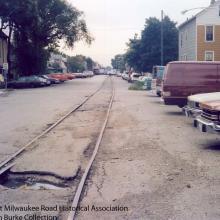
tb_mrha_CandENorthLine_09_1980_08
We are looking south down Lakewood Avenue with Barry Street just ahead. Note the conditions of the tracks. The street signs are still in the old black lettering on a yellow background which used to be common around Chicago. Another rare scene-the AMC Matador sedan in the foreground. In the distant background was another spur that curved off to the left and served George Street Packing. At one time the Milwaukee Road had two pairs of tracks on Lakewood, one of the longest stretches of street trackage in the city. These tracks remained in the street from Belmont south to Diversey for a number of years after operations were cut back to Diversey in 1984.tb_mrha_CandENorthLine_09_1980_08
We are looking south down Lakewood Avenue with Barry Street just ahead. Note the conditions of the tracks. The street signs are still in the old black lettering on a yellow background which used to be common around Chicago. Another rare scene-the AMC Matador sedan in the foreground. In the distant background was another spur that curved off to the left and served George Street Packing. At one time the Milwaukee Road had two pairs of tracks on Lakewood, one of the longest stretches of street trackage in the city. These tracks remained in the street from Belmont south to Diversey for a number of years after operations were cut back to Diversey in 1984.
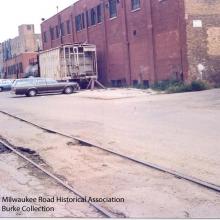
tb_mrha_CandENorthLine_09_1980_09
At the end of the line circa 1980 stands the Reed Candy Company. It produced butterscotch and root beer flavored candies that came in rolls. It was acquired by Wrigley and production was moved to a more modern facility near Yorkville. The Reed Candy building was closed around 1984 and eventually it was torn down in 1987 for the Sweeterville town home complex on the same site. The C&E in 1980 continued across Belmont Avenue for a half block where it kept a tail track for backup moves onto Reed’s spur. An internal Milwaukee Road study from 1982 contemplated realigning the main line of the C&E slightly to the east in Lakewood Avenue so that it would connect to the Reed spur from the south. The Reed spur then would be the new northern terminus of the C&E. That would have eliminated the need for switching across busy Belmont Avenue. But alas, that would not come to as Reed was purchased and production relocated.tb_mrha_CandENorthLine_09_1980_09
At the end of the line circa 1980 stands the Reed Candy Company. It
produced butterscotch and root beer flavored candies that came in
rolls. It was acquired by Wrigley and production was moved to a
more modern facility near Yorkville. The Reed Candy building was
closed around 1984 and eventually it was torn down in 1987 for the
Sweeterville town home complex on the same site. The C&E in
1980 continued across Belmont Avenue for a half block where it kept
a tail track for backup moves onto Reed’s spur. An internal
Milwaukee Road study from 1982 contemplated realigning the main
line of the C&E slightly to the east in Lakewood Avenue so that
it would connect to the Reed spur from the south. The Reed spur
then would be the new northern terminus of the C&E. That would
have eliminated the need for switching across busy Belmont Avenue.
But alas, that would not come to as Reed was purchased and
production relocated.